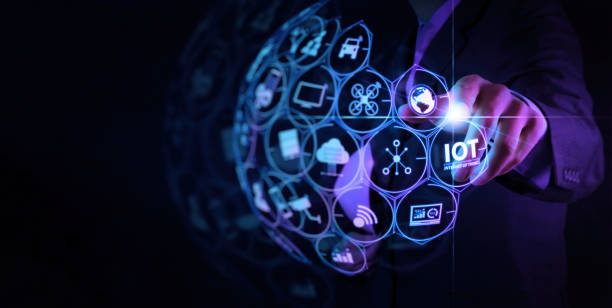Introduction
In the rapidly evolving landscape of technology, the Internet of Things (IoT) has emerged as a game-changer, revolutionizing the way devices communicate and interact with each other. This interconnected network of physical devices, vehicles, appliances, and other items embedded with sensors, software, and network connectivity has opened up endless possibilities for innovation. However, this dynamic ecosystem also poses significant challenges for patent drafting, with the need to protect the intellectual property of these groundbreaking IoT technologies. In this context, the integration of Artificial Intelligence (AI) has proven to be a pivotal force, transforming the process of drafting IoT-related patents.

Understanding the IoT Landscape
The Internet of Things (IoT) has emerged as a transformative force, reshaping the way devices, objects, and systems interact and communicate with each other. This interconnected network of physical devices, vehicles, appliances, and other items embedded with sensors, software, and connectivity capabilities has brought about a paradigm shift across various sectors, ranging from industrial applications and healthcare to smart homes and agriculture.
Key Components of IoT
- Devices: IoT devices encompass a diverse range of physical objects equipped with embedded sensors, actuators, and communication modules. These devices can collect and transmit data, enabling seamless connectivity and interaction within the IoT ecosystem.
- Connectivity: The connectivity layer of IoT facilitates data exchange and communication between interconnected devices. Various connectivity protocols such as Wi-Fi, Bluetooth, Zigbee, and cellular networks enable the seamless transmission of data, fostering real-time monitoring and control capabilities within the IoT network.
- Data Processing: The data generated by IoT devices undergoes processing and analysis, often leveraging cloud computing and edge computing infrastructures. This data processing phase involves extracting actionable insights, performing analytics, and generating meaningful information that facilitates informed decision-making and operational enhancements.
- Applications and Services: IoT applications and services encompass a broad spectrum of solutions tailored to specific industry verticals and consumer needs. These applications range from remote monitoring and predictive maintenance in industrial settings to smart healthcare systems, intelligent transportation, and personalized home automation solutions.
The Need for Patent Protection in the IoT Era
In the era of the Internet of Things (IoT), where interconnected devices and systems drive innovation and efficiency across various sectors, the need for robust patent protection has become increasingly crucial. Patents serve as a fundamental mechanism for safeguarding the intellectual property rights of inventors, companies, and organizations involved in developing cutting-edge IoT technologies. By securing patents, innovators can protect their inventions from unauthorized use, replication, or commercialization by competitors, thereby fostering an environment conducive to sustained innovation and technological advancement. Several key factors underline the critical need for patent protection in the IoT era:
1. Protection of Innovative Solutions
IoT has led to the development of groundbreaking solutions and technological advancements, ranging from smart home devices and wearables to industrial automation and autonomous vehicles. Patent protection enables innovators to safeguard their novel ideas, technical advancements, and proprietary technologies, ensuring that their innovations remain exclusive and protected from exploitation by others.
2. Commercialization and Monetization of IoT Technologies
Patents play a pivotal role in enabling inventors and organizations to capitalize on their IoT-related inventions. By securing patent protection, innovators can leverage their intellectual property assets to commercialize their technologies, negotiate licensing agreements, and generate revenue through product sales, technology transfers, or strategic partnerships. Patent protection serves as a catalyst for transforming innovative ideas into marketable products and services, thereby fostering economic growth and technological progress.
3. Prevention of Patent Infringement and Unauthorized Use
In the highly competitive landscape of IoT, where rapid technological advancements and market disruptions are commonplace, patent protection serves as a shield against potential infringements and unauthorized use of proprietary technologies. Patents provide legal exclusivity, enabling patent holders to enforce their rights and prevent competitors from exploiting their inventions without authorization. By deterring potential infringers and safeguarding against intellectual property theft, patents foster an environment of fair competition and encourage continued investment in research and development within the IoT domain.
4. Encouragement of Research and Development
Robust patent protection incentivizes research and development (R&D) initiatives within the IoT sector, encouraging innovators to invest in pioneering technologies and groundbreaking solutions. By offering a period of exclusivity and the potential for financial returns, patents stimulate R&D efforts, attract investment, and promote a culture of innovation that drives continuous technological advancements and fosters a competitive edge in the global marketplace.
5. Enhancement of Technological Standards and Best Practices
Patents facilitate the establishment of technological standards and best practices within the IoT ecosystem, promoting interoperability, compatibility, and innovation across diverse IoT applications and devices. Standard-essential patents (SEPs) play a crucial role in defining industry standards, ensuring technology interoperability, and fostering a collaborative environment that encourages the widespread adoption of IoT solutions while maintaining a balance between competition and innovation.
6. Promotion of Cross-Industry Collaboration
Patent protection in the IoT landscape encourages cross-industry collaboration and knowledge sharing, fostering an environment where stakeholders can leverage each other’s technological expertise and insights to drive collective progress. Collaborative research initiatives, joint ventures, and strategic partnerships enabled by patent protection facilitate the exchange of ideas, resources, and technical know-how, leading to the development of comprehensive IoT solutions that address complex challenges and meet evolving consumer demands.
7. Global Market Expansion and Competitive Advantage
Securing international patent protection enables IoT innovators to expand their market presence, penetrate new geographical regions, and gain a competitive advantage in the global marketplace. By obtaining patents in key jurisdictions, innovators can establish a strong foothold in diverse markets, protect their intellectual property assets from global competitors, and position themselves as key players in the increasingly interconnected and competitive landscape of the IoT industry.
Challenges in Drafting IoT-Related Patents
Drafting patents for Internet of Things (IoT) technologies presents a unique set of challenges that stem from the complex and interdisciplinary nature of these innovations. These challenges require careful consideration and specialized expertise to ensure comprehensive protection for IoT-related inventions. Several key challenges in drafting IoT-related patents include:
1. Interconnected Systems and Components
IoT technologies often involve interconnected systems and components that communicate and exchange data in real-time. Drafting patents for such interconnected systems requires a deep understanding of the intricate network architecture, data transmission protocols, and communication standards involved. Ensuring that patent claims adequately cover the interconnected nature of these systems while maintaining specificity and clarity poses a significant challenge for patent drafters.
2. Technical Complexity and Interdisciplinary Nature
IoT innovations frequently incorporate diverse technologies, including sensors, actuators, wireless communication protocols, data analytics, and cloud computing. Drafting patents that encompass the various technical components and interdisciplinary aspects of IoT solutions demands a comprehensive understanding of multiple fields, ranging from electronics and telecommunications to software development and data science. Navigating the intricate technical complexities while formulating precise and enforceable patent claims necessitates interdisciplinary collaboration and expertise.
3. Data Security and Privacy Concerns
The proliferation of IoT devices and the massive amount of data they collect raise concerns about data security, privacy, and compliance with regulatory standards. Ensuring that patent claims address data security measures, encryption protocols, and data privacy guidelines is essential to safeguard the integrity and confidentiality of sensitive information. Drafters must demonstrate how IoT inventions incorporate robust data security measures without compromising user privacy or violating data protection regulations, presenting a significant challenge in drafting IoT-related patents.
4. Evolving Standards and Protocols
IoT standards and protocols continue to evolve rapidly, driven by technological advancements and industry developments. Keeping pace with these evolving standards while drafting patents necessitates continuous monitoring of industry trends, participation in standardization processes, and an in-depth understanding of the implications of emerging standards on IoT patent claims. Ensuring that patent claims remain relevant, compliant with industry standards, and adaptable to future technological developments is a critical challenge faced by patent drafters in the IoT landscape.
5. Patent Eligibility and Non-Obviousness
Demonstrating the patent eligibility and non-obviousness of IoT-related inventions in the context of rapidly evolving technological advancements poses a significant challenge for patent drafters. IoT solutions often build upon existing technologies and incorporate incremental innovations, making it challenging to establish the novelty and inventive step required for patentability. Drafters must navigate the intricate landscape of prior art, assess the uniqueness of IoT applications, and articulate how these solutions offer advancements that are non-obvious to persons skilled in the relevant technological domains.
6. Global Patenting Considerations
IoT technologies transcend geographical boundaries and are subject to varying patenting requirements and regulatory frameworks across different jurisdictions. Drafting IoT-related patents that adhere to the legal standards and patentability criteria of multiple jurisdictions poses a considerable challenge, requiring a nuanced understanding of international patent laws, regional variations in patent examination practices, and the nuances of intellectual property regulations in different countries. Harmonizing patent claims to ensure global enforceability and comprehensive protection of IoT inventions remains a complex task for patent drafters operating in the global IoT landscape.
Addressing these challenges requires a comprehensive approach that integrates technical expertise, legal acumen, and a thorough understanding of the evolving IoT ecosystem. By collaborating with interdisciplinary teams, leveraging advanced patent drafting tools and technologies, and staying abreast of the latest industry developments and regulatory guidelines, patent drafters can navigate these challenges effectively and develop robust patent portfolios that safeguard the intellectual property rights of IoT innovators and promote continued innovation in the field.

The Integration of AI in Patent Drafting
AI has emerged as a transformative force in streamlining the process of drafting patents, particularly in the context of IoT. By leveraging advanced algorithms, natural language processing (NLP), and machine learning, AI-powered patent drafting tools offer a host of benefits that significantly enhance the efficiency and effectiveness of the drafting process. These tools enable patent attorneys, inventors, and researchers to navigate the complexities of IoT-related inventions, address patentability criteria, and ensure comprehensive protection for their innovations.
1. Enhanced Prior Art Search and Analysis
One of the key contributions of AI in IoT-related patent drafting is its ability to conduct exhaustive prior art searches and analyses. AI-powered algorithms can swiftly analyze vast repositories of existing patents, scientific literature, and technical documents, providing comprehensive insights into the novelty and inventiveness of the proposed IoT solutions. By automating the process of identifying relevant prior art, AI minimizes the risk of oversights and enables patent drafters to develop stronger, more defensible patent claims.
2. Optimized Claim Construction and Language Generation
AI’s proficiency in natural language processing plays a pivotal role in optimizing claim construction and language generation within IoT-related patent drafts. AI-powered tools can interpret complex technical jargon, analyze patent specifications, and generate precise, well-structured patent claims that adhere to legal and technical standards. This capability not only expedites the drafting process but also minimizes errors and ambiguities, thereby strengthening the enforceability of IoT-related patents in the long run.
3. Predictive Analysis and Intellectual Property Strategy
Furthermore, AI facilitates predictive analysis and forecasting, empowering patent drafters to develop robust intellectual property strategies within the realm of IoT. By analyzing market trends, technological developments, and competitive landscapes, AI-driven tools assist stakeholders in making informed decisions regarding patent filing, portfolio management, and licensing opportunities. This proactive approach enables organizations to strategically position their IoT-related patents, capitalize on emerging opportunities, and mitigate potential risks associated with infringement or litigation.
4. Facilitation of Collaborative Patent Drafting and Review
Collaborative patent drafting and review are integral components of the patenting process, requiring seamless communication and coordination among multiple stakeholders. AI platforms equipped with collaborative features streamline this process by enabling real-time collaboration, version control, and feedback integration. These tools facilitate effective communication between inventors, patent attorneys, and technical experts, fostering a synergistic approach to drafting IoT-related patents and ensuring that all relevant insights are incorporated into the final patent application.
5. Integration of IoT-Specific Legal and Regulatory Knowledge
The convergence of IoT technologies and legal complexities necessitates a comprehensive understanding of the regulatory landscape governing IoT-related patents. AI-powered platforms integrate IoT-specific legal knowledge and regulatory frameworks, ensuring that patent drafts adhere to pertinent guidelines and compliance requirements. By staying abreast of evolving legal standards and jurisdiction-specific nuances, AI-driven patent drafting tools enable stakeholders to navigate the intricate legal terrain, minimize legal risks, and strengthen the enforceability of IoT-related patents on a global scale.
6. Addressing Ethical and Security Concerns
Given the proliferation of IoT devices and the sensitive data they collect, ensuring data privacy, security, and ethical considerations within IoT-related patents is of paramount importance. AI-powered patent drafting tools aid in addressing these concerns by incorporating data protection protocols, encryption methodologies, and ethical guidelines into the patent drafting process. By emphasizing the ethical implications of IoT innovations and emphasizing the importance of data security, AI promotes responsible and sustainable practices that align with evolving societal expectations and regulatory mandates.
Overcoming Challenges and Future Prospects
While AI has revolutionized the landscape of IoT-related patent drafting, certain challenges persist, necessitating continuous innovation and refinement of AI-driven solutions. Challenges such as the interpretation of complex technical concepts, addressing non-obviousness requirements, and ensuring patent eligibility for IoT inventions underscore the need for ongoing advancements in AI technologies. Furthermore, the evolution of international patent standards, the emergence of new IoT applications, and the interplay between AI and IoT necessitate adaptive and agile patent drafting methodologies that can keep pace with this rapidly changing landscape.
Looking ahead, the fusion of AI with emerging technologies such as blockchain, quantum computing, and edge computing holds the potential to redefine the contours of IoT-related patent drafting. By harnessing the power of AI-driven predictive analytics and cognitive computing, stakeholders can anticipate future trends, identify untapped opportunities, and devise comprehensive intellectual property strategies that align with the evolving demands of the IoT ecosystem.
Conclusion
In conclusion, the integration of AI has revolutionized the process of drafting IoT-related patents, offering a host of capabilities that streamline the complexities and challenges associated with protecting intellectual property in the IoT landscape. From enhancing prior art searches and optimizing claim construction to facilitating collaborative drafting and addressing ethical considerations, AI-driven solutions have reshaped the patenting landscape, empowering stakeholders to navigate the intricate nuances of IoT innovation with greater precision and efficiency. As the synergy between AI and IoT continues to evolve, the future of patent drafting holds immense promise, driven by continuous innovation, interdisciplinary collaboration, and a proactive approach to addressing the evolving needs of the global IoT ecosystem.

Leave a Reply